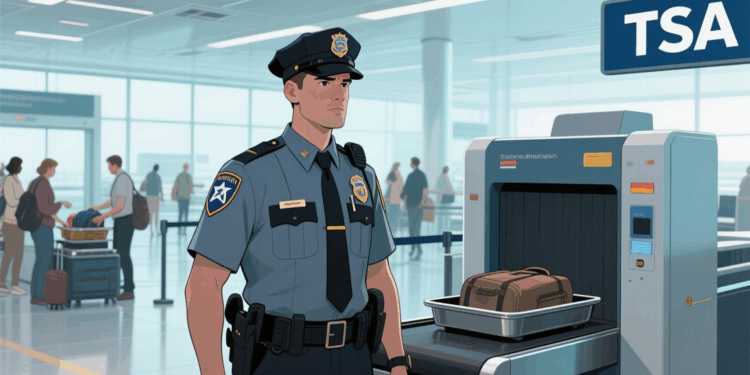The Transportation Security Administration (TSA) is a federal agency tasked with ensuring the security of the U.S. transportation systems. Its primary mission is to protect passengers, cargo, and infrastructure from threats while maintaining efficient travel operations. The agency operates under the Department of Homeland Security (DHS) and collaborates with various stakeholders to implement security measures.
History of the TSA
Founded: November 19, 2001 (after 9/11 attacks)
Part of: Department of Homeland Security (DHS)
Original Purpose: Replace private airport security with federal oversight
Key Milestones:
- 2001: Aviation & Transportation Security Act signed
- 2010: TSA PreCheck launched
- 2020: COVID-19 health measures introduced
- 2023: New AI-powered scanners deployed
Leadership (2025)
- Administrator: David Pekoske (since 2017, reappointed in 2021)
- Headquarters: Springfield, Virginia
- Employees: ~60,000 (TSA Officers, Federal Air Marshals, etc.)
TSA’s Mission and Organization
The TSA oversees airport passenger and baggage screening to prevent prohibited items from entering aircraft. It also manages air cargo security, ensuring the safe transport of goods. Additionally, the agency enforces surface transportation security, covering rail systems, ports, and pipelines.
Another critical function is intelligence analysis and threat detection, where the TSA identifies and mitigates potential risks to transportation networks.
TSA Airport Screening Procedures
The Transportation Security Administration (TSA) implements strict security screening procedures at U.S. airports to ensure passenger safety while maintaining efficient travel.
1. Passenger Screening
ID Verification: Must match boarding pass (Real ID required starting May 7, 2025)
Body Scanners:
- Advanced Imaging Technology (AIT) – Detects metallic/non-metallic threats
- Pat-downs (if flagged or opt-out)
Shoes Off? Required unless in TSA PreCheck
2. Carry-On Screening
3-1-1 Liquids Rule:
- 3.4 oz (100ml) max per container
- 1 quart-sized clear bag
- 1 bag per passenger
Electronics: Laptops and tablets must be separated in bins
New AI Scanners (2025): Faster detection, fewer false alarms
3. Checked Baggage Screening
- CT Scanners: High-resolution 3D imaging
- Random Inspections: Some bags opened manually
TSA During COVID-19 (2020-2024)
- Mask Mandate: Ended April 2022
- Sanitization: Enhanced cleaning of bins & surfaces
- Touchless Tech: More self-service kiosks
- Vaccine Rules: None for domestic flights (some international destinations required proof)
Common Passenger Questions
Do I need a REAL ID to fly in 2025?
Can TSA see my private body scans?
What if I’m selected for extra screening?
Can I bring food through TSA?
Tips for a Smooth TSA Experience
Arrive Earlier Than You Think You Need To
- Domestic flights: 2+ hours before boarding
- International flights: 3+ hours (extra screening possible)
- Holidays/busy airports? Add 30-60 extra minutes
Pack Smart to Avoid Delays
Do This:
- Use clear toiletry bags for liquids (3-1-1 rule).
- Keep electronics accessible (laptops, tablets in easy-to-reach spots).
- Wear slip-on shoes (easy removal if not in PreCheck).
- Empty pockets before screening (keys, phones, wallets go in bag).
And avoid this:
- Overpacking bins (TSA may rescan).
- Wearing excessive metal (belts, jewelry slow you down).
- Bringing prohibited items
Have Your ID and Boarding Pass Ready
- Real ID required starting May 7, 2025 (or use a passport).
- Mobile boarding passes? Brighten your screen for scanning.
- Kids under 18 don’t need ID for domestic flights.
Choose the Right Security Lane
| Lane Type | Best For | Perks |
| Standard | Everyone | – |
| TSA PreCheck | Trusted travelers | Keep shoes on, laptops in bag |
| CLEAR | Speed + biometrics | Skip ID check (combine with PreCheck for fastest pass) |
| Family/Special Assistance | Kids, disabilities | More time and help |
Prepare Electronics for Screening
- Laptops and tablets must go in a separate bin.
- Small electronics (phones, e-readers) can stay in bags if in PreCheck.
- Power banks and loose batteries must be in carry-ons (not checked bags).
Dress for Easy Screening
- Slip-on shoes (avoid lace-ups).
- Minimal jewelry/metal (or remove before scanning).
- Jackets and belts off (unless in PreCheck).
Avoid: Steel-toe boots, heavy jewelry, or clothing with excessive metal.
Traveling with Kids? Know These Rules
- Strollers and car seats must be screened (sometimes hand-checked).
- Baby food/milk is exempt from 3-1-1 (reasonable quantities allowed).
- Kids 12 and under can keep shoes on.
Know Your Rights During Screening
You can request:
- A private screening if patted down.
- A supervisor if you feel unfairly treated.
- No photos/videos of screening areas (TSA prohibits it).
You must comply with:
- All lawful instructions (refusal = denied boarding).
- Additional screening if flagged (random or behavior-based).
Frequently Asked Questions about TSA
Do I need a REAL ID to fly in 2025?
How early should I arrive at the airport?
Can I bring a water bottle through TSA?
Can I bring power banks or spare batteries?
Can I bring a gun or knife in my carry-on?
Do kids need ID to fly?
Can I opt out of body scanners?
Can I bring vaping devices?











